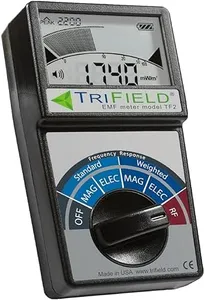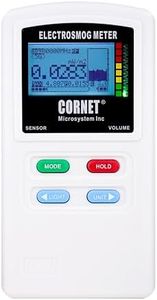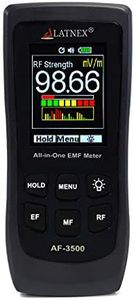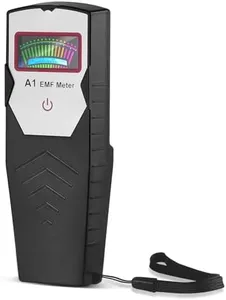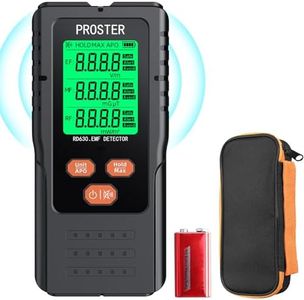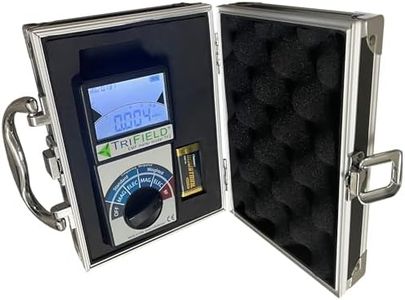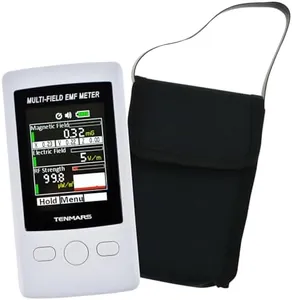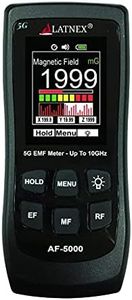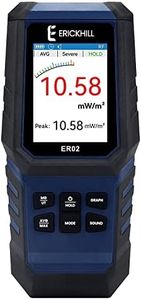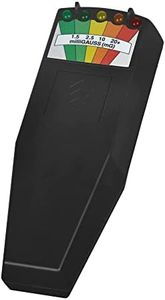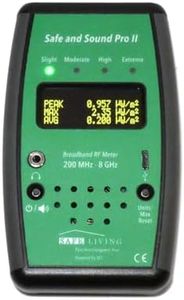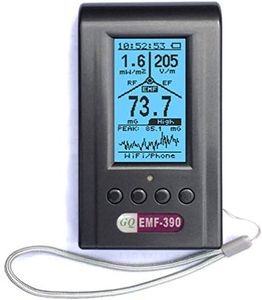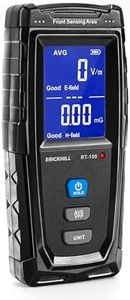Our technology thoroughly searches through the online shopping world, reviewing hundreds of sites. We then process and analyze this information, updating in real-time to bring you the latest top-rated products. This way, you always get the best and most current options available.

Our Top Picks
Winner
TriField TF2 Electromagnetic Field EMF Meter
The TriField TF2 Electromagnetic Field EMF Meter is a versatile tool for measuring electromagnetic pollution, capable of detecting AC magnetic, AC electric, and RF/microwave fields. Its ability to capture fast pulses with the Peak Hold feature is beneficial for users needing to measure digital signals. The 3-axis AC magnetic measurements ensure accurate readings without worrying about the meter's orientation, which is a strong point for ease of use.
Additionally, the audio indicator is helpful for pinpointing EMF sources, providing an audible cue for users to locate emissions. With adjustable backlight, the display is convenient in low-light environments, enhancing readability. However, it lacks data logging and connectivity features, which might be a drawback for those wanting to store and analyze data over time.
The meter is battery powered, but users need to purchase their own batteries, as they are not included. Its lightweight design makes it portable, although some users may find the small size less robust. The TriField TF2 is a suitable choice for individuals keen on monitoring various EMF types with straightforward functionality, despite its limitations in advanced data management tools.
EMRSS Cornet ED98QPro5G Latest Version Quad-Mode Meter: RF/LF Electrosmog Field Strength Power Meter with Built-in Gauss Meter, Electric Field Meter and Light Flicker
The EMRSS Cornet ED98QPro5G EMF meter offers impressive versatility with its quad-mode design, allowing it to measure multiple types of electromagnetic fields and light flicker rates. It covers a wide frequency range, with RF capabilities from 100MHz to 8GHz, making it well-suited for detecting modern signals, including 5G. Sensitivity levels are also notable, with very low thresholds for detecting LF magnetic fields and RF signals, providing reliable readings for both residential and business environments. This makes the device especially useful for those concerned about electromagnetic wave safety and LED light flicker in their surroundings, addressing health standards regulated by the EU and USA safety norms like IEEE1789.
A user-friendly interface ensures ease of operation, which is handy for users not deeply familiar with technical details. The display provides clear readings, while data logging for up to 50 hours is a significant feature for tracking field fluctuations over time. However, the device's lightweight design and comprehensive support, including technical assistance and a one-year warranty, add value to the purchase.
On the downside, the meter has been available since 2016, which might lead users to consider newer alternatives with potentially updated technology or features. Additionally, while batteries are included, it requires alkaline batteries, which need regular replacement. Although the product is well-regarded in its category, potential buyers should consider their specific needs and compare it against other products before making a decision.
LATNEX AF-3500 EMF Meter RF Detector and Reader with Calibration Certificate - Measures RF and Microwaves, 3-Axis Gauss Magnetic Fields and Electrical Fields ELF
The LATNEX AF-3500 EMF Meter is a versatile device designed to measure different types of electromagnetic fields, including radiofrequency (RF) signals from 50 MHz to 3.5 GHz, low-frequency electrical fields up to 2000 V/m, and 3-axis magnetic fields. This wide frequency range covers common sources like cell phones, WiFi routers, smart meters, and power lines, making it suitable for general home or personal EMF detection needs. Its 3-in-1 design lets you switch easily between RF, electrical, and magnetic field modes, which adds convenience for users who want to check various types of EMF without needing multiple devices. The large screen and big buttons improve readability and ease of use, especially for seniors or beginners. The alarm function helps alert you if EMF levels cross a preset limit, adding a safety feature that’s handy in everyday use.
Data logging is manual, allowing you to record maximum and average readings, but it lacks automatic data storage or wireless connectivity, which might be limiting if you want to track exposure trends over time or analyze data on a computer. The meter comes with a calibration certificate, ensuring reliable measurements, and the manufacturer provides free technical support and an easy return policy, which is reassuring for new users. On the downside, the meter relies on AAA batteries, which may need replacing regularly, and the weight is around 454 grams, making it slightly heavier compared to some compact models.
With a customer rating of 4.0 out of 5 and a decent position in electrical testing tools, this meter represents a solid choice for those needing a multifunctional, user-friendly EMF detector without advanced data logging features.
